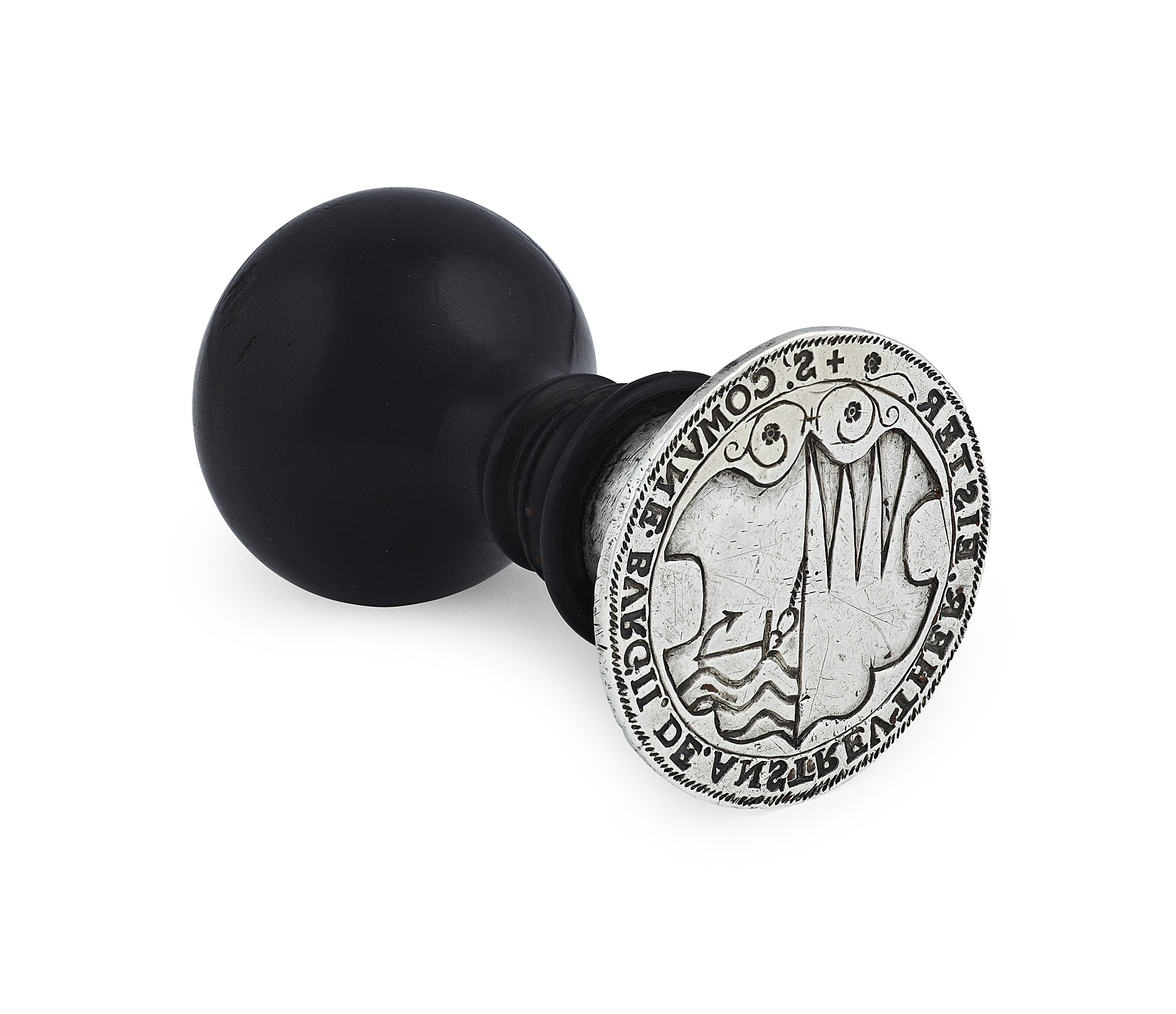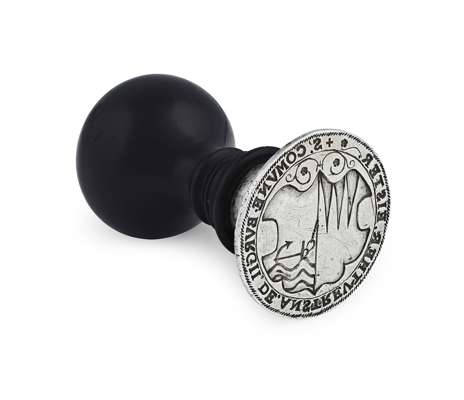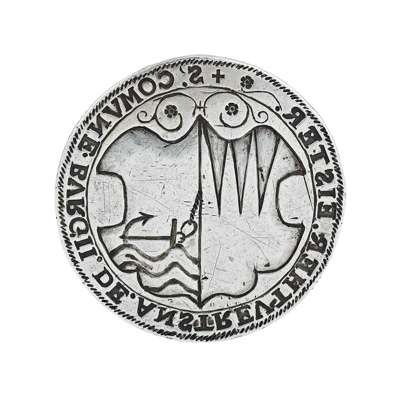
Lot 105

An important early 17th century Scottish Burgh seal








Auction: 16 August 2011 at 12:00 BST
Description
David Milne (probably), Edinburgh 1613 - 1614, Deacons mark of George Crawford, with zig zag assay scrape, with additional makers mark to collar, the matrix with central armorial shield scroll and flower heads surmounts, the whole enclosed motto '+S'.COMUNE. BVRGH. DE. ANSTREVTHER. EISTER.', with simple socket mount and turned ebony baluster handle
Dimensions
matrix 52mm diameter, height (overall) 94mm
Footnote
Provenance:
In the family papers of Alexander Woodcock (1822 - c1899), Lawyer St. Andrews
Private Collection
Note on seal:
To date, only one other marked pre-1700 Scottish silver seal has been recorded; the Portsburgh seal matrix by Andrew Denniestoun of Edinburgh, dated 1648 - 1650. This seal, while bearing strong similarities in the style of engraved motto and borders, is of a far more elaborate design. However, it is interesting to note that even thirty five years later, the style of manufacture and use of punched details (for example the flower heads in the Anstruther seal and the quatro and cinquefoils in the Portsburgh example) remains the same.
The shield in which the Burgh arms are placed within this example has many comparables within Scottish silver. Indeed, from engraved arms on communion cups and mazers to those on the earliest sporting medals, arms and initials engraved within a shield of this bold, waisted style are common place. The Anstruther piece bears a particularly accomplished, high quality example of such a feature.
Notes on armorial:
This previously unrecorded armorial falls well before the first record taken of Scottish Burgh and Corporate seals in 1672 and is, therefore, the earliest representation of a burgh seal for the 'Royal Burgh of Kilrenny, Anstruther Easter, Anstruther Wester'. The 1672 survey does record that arms had been used by the three burghs prior to 1672 but until now examples had failed to surface. The arms used on this piece are comparable to the later recorded examples but the exact placement and style is so far unique.
The sinister side of the arms shows the greatest similarity to the two later examples known for the burgh. These two seals are recorded as using an anchor and 'parted per fess three bars wavy in base'. The Sinister shield to this piece seems in some ways to combine both of these features, although not strictly in form. The dexter side of the arms bears the 'three piles sable' of the family; Anstruther of that Ilk - the family that were instrumental in the establishment of the burgh.
Notes on Anstruther:
Anstruther - Easter is the smallest parish in Scotland, its boundaries, including the Royal burgh from which it takes its name, extending to no more than five and a quarter acres. It was made a Royal burgh by special act of Parliament firstly in 1583 and the again by subsequent acts through the 16th and 17th centuries. Previously it is noted in the Register of the Great Seal on the 10th of March 1571 - 72 that Anstruther - Easter was created 'a burgh of barony' under Anstruther of that ilk.
The connection between the Anstruther family and the burgh goes back further than the granting of these charters. Records for the family begin to appear in the 12th century with the first construction of the baronial Castle of Dreel outside the town of Anstruther.
The history of the Anstruther family is one of influence and power, not just in Scotland but into the Continent. The family were staunch followers of the Stuart monarchy, supporting the cause at such battles as Flodden and Pinkie Cleugh. Sir James Anstruther, whose grandfather had fallen at Pinkie Cleugh, was a great favourite of King James VI and was bestowed the title of Hereditary Caver in 1585, going on to be knighted and made a Master of the Household in 1592. His eldest son William; another staunch Royal supporter who accompanied King James to England in 1603, was rewarded as a Knight of the Bath on the King's accession to the British throne. William went on to survive the troubled reign of Charles I, witnessing the King's execution in 1649 shortly before his own death.
His heir (his brother's eldest son), Sir Robert Anstruther, was to become perhaps one of the most powerful political figures within the family's history. Originally sent as Ambassador to the Court of Denmark in 1620 his career in the Royal courts of Europe flourished. In this position he was a most trusted adviser to King James VI and a large archive of correspondence between the two still survives in the Royal Archives in Copenhagen. Indeed, his trust and reputation within the Royal family was so strong that he was selected by Queen Anne in 1613 (interestingly the date of this seal) to deliver the most private correspondence between her and her brother. Later in his career Sir Robert was also given the duty of negotiating a resolution between the Emperor of Germany and the King of Denmark in 1626.
The original baronial seat of the Anstruther's, Castle Dreel, also features prominently within the early history of the area. Noted as being 'a square tower of great strength built on the margin of the Dreel burn close by the sea'. It was considered of such 'strength' that in sight of the invading Cromewellian forces in 1651, the burgesses of Anstruther stored valuable goods, papers and important wares within the tower for safety, in belief they would be saved from the armies moving northwards. This turned out to be ill-placed confidence and the castle soon fell to the advancing forces. The items stored within, including the burgh papers, were taken by the army as spoils of war and shipped to Cromwell in London. Sadly, the ship was destroyed enroute and the papers (among many other important Scottish relics and records) were lost.
The working life of the baronial castle would continue, playing host to King Charles II on his tour of the Kingdom of Fife in 1651 and, even after falling into disrepair in the early 18th century, becoming the venue for the colourful revelries and rituals of the 'Beggars Benison'.
Notes on maker:
This piece appears to be the only recorded example to bear the maker's mark of 'DM' conjoined for David Milne (aka Miln, Mylne, Myle). As no other example can be drawn on for comparison, the attribution must remain cautious. However, the name can be used with some certainty as it appears to be the only name for the period that would fit the initials.
The tight date frame of 1613 - 1615 does not appear open for debate as the Deacon's mark is firmly ascribed to George Crawford and the Edinburgh town punch is the same punch as recorded on other pieces for this first period of him acting as Deacon.
Records for David Milne show he was apprenticed to the Edinburgh goldsmith James Mossman II in 1563. It is not, however, until 1573 that he is set an essay for entry and eventually granted the freedom of his trade on 6th December 1573.
It is thought that it was during the intervening years Milne completed his training in London. In 1568 it is noted 'David Mylne Scottysman, working with Howell Podmore, became free of the Worshipful Company of Goldsmiths, London, 17 May 1568' - it seems safe to assume that he worked as a journey man for Podmore as no punch or work is recorded for this period.
Milne's second appearance within the records of the Incorporation of Goldsmiths of the City of Edinburgh is in 1590 and he is last mentioned in 1614. During this time he twice holds the position of 'adjuster of weights' and appears to have been an active member of the Incorporation.
References:
See 'Scottish Heraldic Seals - Royal Official, Ecclesiastical, Collegiate, Burghal, Personal' volume I, page 53, by J.H. Stevenson, K.C. & M. Wood, Phd, for the two later currently recorded Burgh seals of Anstruther.
For early history and illustration of the two seals of the Burghs of East and West Anstruther see 'Fife Pictorial and Historical ' A. H. Miller, Volume 1 pages 403 - 414
For illustration and discussion on the Easter and Wester Anstruther Burgh seals see 'The Town Council seals of Scotland, Historical, Legendary and Heraldic' A Porteous,
"Edinburgh Goldsmiths'' Minutes 1525-1700'' Transcribed by J. Munro B.A, Ph.D, edited by H Steuart Fotheringham O.B.E







